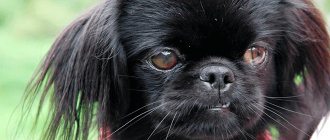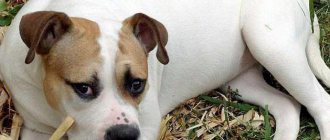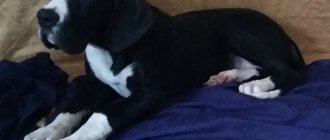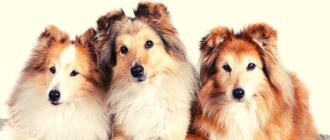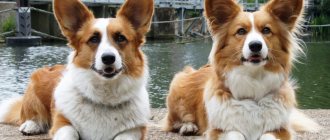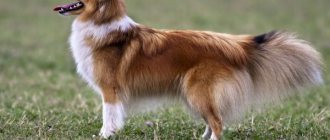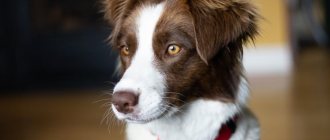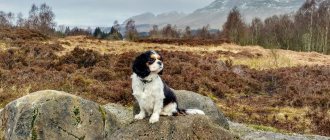| Origin: | Japan |
| Usage: | hunting dog, companion |
| Color: | red, black and tan, sesame |
| Dimensions: | height 37-40 cm +/- 1.5 cm, weight 8-10 kg |
| Lifespan: | 13-15 years old |
Shiba Inu (or Shiba) is an ancient Japanese breed. This is an unusually charming and charismatic dog that has become popular in many countries around the world. But an animal requires a special approach - not everyone can find a common language with a pet. The article provides basic information about the breed - origin, appearance, temperament and maintenance characteristics.
Character
The Shiba Inu has a cheerful, perky, friendly, but cunning and slightly capricious character. For a pet to reveal its positive qualities, it needs a competent leader with a firm hand.
Representatives of the breed are very active and need constant movement and entertainment. The Shiba Inu will not be able to play the role of a sofa pet - it needs to realize the potential inherent in nature. Moreover, physical activity should alternate with intellectual activity.
The Shiba dog is smart, but problems often arise during training - a special approach is needed to the pet. Representatives of the breed are very independent. Most often, adolescent animals demonstrate disobedience. During puberty, they often test their owners' strength. If you give up the slack, the mini Akita Inu will take the position of leader and begin to dominate all family members.
To achieve obedience, the owner should build a partnership with the pet. The Mini Akita does not believe that it owes anything to humans.
Until the dog wants, nothing will force him to perform the required action. Therefore, the animal needs to be shown that its interests are also taken into account, and its opinions are listened to.
Shiba Inu colors with photos
According to the standard, three colors are allowed for Shiba Inu: red, black and tan and sesame. For any suit, the so-called “urajiro” is required. This is a specific coloring characteristic of indigenous Japanese breeds. Formed by white hairs located:
- on the sides of the muzzle;
- on the throat;
- lower neck and chest;
- on the stomach;
- bottom of tail;
- on the inside of the limbs.
Additional Information! There are also white Shiba Inus. They are not recognized by all cynological organizations, with the exception of the Japanese Shibaho.
Ginger
Red color
Shiba-ken are red or red in color most of all: about 80% of all dogs. Any shades are acceptable, but very light (cream, milky) or dark (the color of baked clay) are undesirable.
The color is characterized by a rich red upper guard hair and a white or ash undercoat. A few black or dark brown hairs on the back and tail are also acceptable. This option is considered a subtype of suit and is called “sashige”.
Red dog breeds with photos
Black and Tan
Black and Tan
The Black and Tan Shiba Inu is less common. This color is complex: it combines not only the main color of black and white tan, but also areas of red, ash and brown.
The black and tan color of the Shiba Inu looks very beautiful in the sun. Under the rays, the fur coat shimmers and “plays” with all shades.
Sesame
Sesame color
Sesame is also called zonal or sesame by Europeans, and goma by the Japanese. This is the rarest and most complex color of the Shiba Inu. The type is similar to the sable coloring familiar to Russians.
Sesame-colored dogs have a red coat strewn with black hairs over the entire surface. Dogs of this color are divided into three types:
- pure Shiba: with equal numbers of black and white hairs;
- black Shiba Inu: dark hairs predominate over white ones;
- red Shiba-ken: there are black hairs on the main red background.
Socialization
Shiba Inu puppies are actively socialized from 2.5 to 7 months. At this time, the pet should receive as many new experiences as possible, learn to interact adequately with the outside world, and calmly communicate with strangers and other dogs. An animal’s bad habits acquired in childhood will be very difficult to correct in the future.
A pet Shiba Inu cannot be hit. The worst punishment is short-term isolation in a separate room with absolutely nothing to do.
Shiba Inu and children quickly become fast friends. The pet perceives a small child as an equal. But a dog is not a toy. The animal will not tolerate disrespectful treatment.
With teenagers, the Mina Akita will happily run around in the fresh air, splashing out its pent-up energy.
A mini Akita and a cat will get along if they met as children. Otherwise, clashes between animals for the dominant position in the pack are possible. However, most often cohabitation proceeds calmly - on the Internet you can find many photos of a Shiba Inu dog and a representative of the feline sleeping or playing together. The situation is somewhat more complicated with other pets. The Shiba dog does not like birds and small rodents - the hunting instinct makes itself felt.
How to choose a puppy
Before getting a mini Akita, it is worth visiting exhibitions and talking with breeders and other owners. It’s better to find out everything about the Shiba dog breed in advance so that there are no unpleasant surprises later.
Shiba Inu puppies:
- brave;
- active;
- curious;
- moderately well-fed.
Healthy babies have clean ears, eyes and fur. Animals are not afraid of strangers and show a keen interest in everything that happens. A responsible breeder will definitely tell you everything about the Shiba Inu and point out the pros and cons of the breed. If a person does not make contact, it is better to refuse the purchase.
Before choosing a puppy, it is recommended to get to know its parents - good heredity guarantees the health of the animal. Shiba Inus should not show obvious deviations from the standard, show aggression or be afraid of strangers. It’s good if manufacturers have documents confirming the absence of hereditary diseases.
Purchase Features
If you want to buy a puppy for the soul, and not for mating and exhibitions, you will need approximately 15,000 rubles . But most often such animals are sold at much higher prices; the average price in Russia is about 60,000 rubles . Animals must be vaccinated and have all the necessary documents.
An adult specimen can be purchased cheaper. This is due to the fact that adult dogs are in less demand than puppies. In addition, by the age of one year, Sibu Inus already have a formed character and get used to their owner. It will be difficult for them to adapt, and it will be difficult for a person to make friends with them.
Since bitches are in great demand on the market, their prices are slightly higher. Usually a male dog can be purchased for 10,000 cheaper.
Features of maintenance and care
The Shiba Inu is suitable for both indoor and outdoor living. Dogs live well in a yard or in an enclosure if they have a warm kennel. But the area must be surrounded by a high fence, otherwise the curious dog will run away.
When kept in apartments, pets are provided with daily walking. Well-mannered Shiba Inu behave quite quietly and do not bark unless necessary.
Caring for your pet will not cause serious trouble - by nature, these animals are very clean. They carefully avoid mud and puddles, and after walks they lick themselves, like cats.
Grooming
Caring for representatives of the breed is not difficult, but you need to know some features. Shiba Inu grooming consists of:
- periodic washing;
- combing the fur coat;
- eye, ear and oral hygiene;
- trimming nails if necessary.
It is enough to brush your pet's fur 2-3 times a week. Shiba Inu dogs shed twice a year. During this period, it is advisable to tidy the coat daily, otherwise the entire apartment will be covered with fallen undercoat. Ignoring the procedure is fraught with skin problems.
A massage brush with medium-hard bristles is suitable for brushing a Shiba dog. During molting, a slicker is used. The animal's fur is pre-moistened with conditioner.
Representatives of the breed are usually not cut so as not to disturb their natural appearance. You can only remove the hair between the paw pads to prevent the dog from slipping on smooth surfaces. Before the exhibition, it is advisable to have your Shiba Inu professionally groomed.
Shiba Inu is bathed a couple of times a year or when dirty. However, it is not recommended to do this too often - the wool will lose its natural protective sheath. It is very difficult to get your pet's fur wet due to the thick undercoat. The animal is watered for a long time from the shower, directing the stream of water against the growth of the fur.
It is recommended to purchase special cosmetics for washing dogs - human shampoos disrupt the natural structure of the fur. After bathing, the pet is thoroughly dried with a towel. It is not advisable to use a hairdryer - hot air dries out the animal’s skin greatly.
Shiba Inu grooming also involves the following procedures:
- 1-2 times a week – cleaning the ears and eyes with a cotton swab;
- every 3-4 days – brushing teeth with veterinary paste and a special brush;
- 1-2 times a month - trimming nails, if the dog does not grind them down on asphalt or other hard surfaces.
Dogs are taught hygiene procedures from childhood - affectionately but persistently, after active games or walks. If the puppy tolerates all the manipulations, he is generously praised and treated with a treat.
Walk
When keeping a Shiba Inu in an apartment, pets are walked twice a day for at least 40 minutes. If the dog lives in an enclosure, then it is better to spend more time communicating and playing together.
During the walk, animals must be kept on a leash. Having smelled an interesting smell, the dog stops seeing and hearing those around him. The pet can only be released in a fenced area or a special area.
If a pet doesn’t move much, it starts to play pranks - chewing furniture, dragging and ruining things.
Feeding
Shiba Inu is given ready-made premium or super-premium food or natural food. In the latter case, the basis of the dog’s diet is lean meat and high-quality offal – up to 50%. What can you feed your Shiba Inu:
- sea fish fillet;
- porridge (rice, buckwheat);
- vegetables;
- fresh herbs;
- dairy products.
Once a week, pets are allowed to gnaw on large bones; in agreement with the veterinarian, vitamin and mineral complexes are administered.
Animals are strictly contraindicated:
- pork;
- spicy, salty, pickled or smoked foods;
- bakery and confectionery products.
Some dogs are allergic to poultry. Shiba Inu should not be fed from the human table, encouraging begging.
Health
Native Japanese dogs are distinguished by excellent health. There will be no problems if:
- the animal's parents do not have hereditary diseases;
- the owner maintains hygiene, feeds properly, and walks the pet regularly;
- For preventive purposes, the dog is examined by a specialist once every six months.
With proper care, the life expectancy of a Shiba Inu is 13-15 years.
Diseases
The list of diseases that Shiba dogs are prone to is very short:
- osteochondritis;
- cataract;
- retinal atrophy;
- patella;
- elbow/hip dysplasia.
Some representatives of the breed suffer from allergies to foods and cosmetics.
Vaccinations
Many diseases lead to the death of a pet, so vaccination is mandatory for all dogs. Injections are not given:
- pregnant bitches;
- sick dogs;
- for non-dewormed pets or immediately after deworming;
- before and after surgery, birth of puppies.
The breeder gives the first vaccinations to puppies at the age of 7-8 weeks. Animals are protected from:
- carnivore plague;
- parvovirus enteritis;
- infectious hepatitis;
- leptospirosis;
- parainfluenza.
After 3-4 weeks, a second vaccination is carried out; at six months of age, the animals are given an injection against rabies. In the future, dogs are given comprehensive vaccines annually.
In Russia and abroad
There is an opinion that buying a puppy abroad, particularly in Japan, is cheaper, but this is not true. The average cost of such a purchase is 2500-3000 euros . But do not forget about the costs of transportation and sanitary control for the dog.
In addition, you can often encounter a problem when breeders do not want to send dogs to Russia; it is very difficult for them to prepare documents that will be accepted by the RKF.
There will be fewer problems and costs when purchasing a pet in our homeland. Moscow has the highest cost. Nurseries offer prices from 80,000 to 140,000 rubles . It is most profitable to buy in Novosibirsk. There you can buy a pet from 50,000 rubles .
Mating
The Japanese Shiba Inu dog breed is rarely found in Russia, so finding a suitable partner for mating is quite difficult. Only sexually mature and fully formed animals that are 1.5 years old are allowed to reproduce.
The best days for dogs to mate are from 10 to 15 from the start of estrus. The animals are first introduced on a walk, then the bitch is brought to the male.
Dogs are most often bred in a freestyle manner - human intervention is required in rare cases. After 24-48 hours, a control mating is carried out to increase the likelihood of conception. Pregnancy of a Shiba Inu lasts 58-66 days. 4-6 puppies are born in a litter.
What does the price depend on?
Shibu Inu is a stately and beautiful animal. There are generally accepted standards based on which the price varies. The most expensive dogs are those with good pedigree, no higher than 41 cm at the withers. The ratio of height to body length is 10:11.
Another important indicator when assessing value is the absence of defects. Among them: cowardice, short or tall stature, snacking. A dog with drooping ears or a tail will not interest the buyer at all, as these are disqualifying faults.
